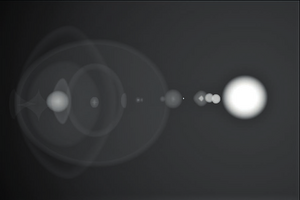Information
- Publication Type: Master Thesis
- Workgroup(s)/Project(s):
- Date: March 2017
- Date (Start): 2016
- Date (End): 2017
- TU Wien Library:
- First Supervisor: Werner Purgathofer
Abstract
Lens flare is a visual phenomenon caused by interreflection of light within a lens system. This effect is often undesired, but it gives rendered images a realistic appearance. In the area of computer graphics, several simulation based approaches have been presented to render lens flare for a given spherical lens system. An accurate model of the lens system and all its components is crucial for a physically reliable result. Since the effect differs from camera to camera, these methods are not flexible, and the internal parameters – especially the anti-reflection coatings – can only be approximated. In this thesis we present a novel workflow for generating physically plausible renderings of lens flare phenomena by analyzing the lens flares captured on a camera. Furthermore, our method allows to predict the occurrence of lens flares for a given light setup. This is an often requested feature in light planning applications in order to efficiently avoid lens flare prone light positioning. A model with a tight parameter set and a GPU-based rendering method allows our method to be used in real-time applications.Additional Files and Images
Weblinks
No further information available.BibTeX
@mastersthesis{Walch-2017-DA,
title = "Lens Flare Prediction based on Measurements with Real-Time
Visualization",
author = "Andreas Walch",
year = "2017",
abstract = "Lens flare is a visual phenomenon caused by interreflection
of light within a lens system. This effect is often
undesired, but it gives rendered images a realistic
appearance. In the area of computer graphics, several
simulation based approaches have been presented to render
lens flare for a given spherical lens system. An accurate
model of the lens system and all its components is crucial
for a physically reliable result. Since the effect differs
from camera to camera, these methods are not flexible, and
the internal parameters – especially the anti-reflection
coatings – can only be approximated. In this thesis we
present a novel workflow for generating physically plausible
renderings of lens flare phenomena by analyzing the lens
flares captured on a camera. Furthermore, our method allows
to predict the occurrence of lens flares for a given light
setup. This is an often requested feature in light planning
applications in order to efficiently avoid lens flare prone
light positioning. A model with a tight parameter set and a
GPU-based rendering method allows our method to be used in
real-time applications.",
month = mar,
address = "Favoritenstrasse 9-11/E193-02, A-1040 Vienna, Austria",
school = "Institute of Computer Graphics and Algorithms, Vienna
University of Technology ",
URL = "https://www.cg.tuwien.ac.at/research/publications/2017/Walch-2017-DA/",
}

 thesis
thesis


